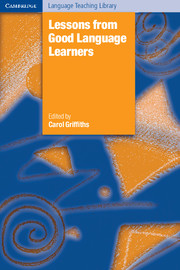Book contents
- Frontmatter
- Contents
- List of contributors
- Acknowledgements
- Editor's overview
- Prologue
- Reflections
- Part I Learner variables
- Part II Learning variables
- 12 Vocabulary and good language learners
- 13 Grammar and good language learners
- 14 Functions and good language learners
- 15 Pronunciation and good language learners
- 16 Listening and good language learners
- 17 Speaking and good language learners
- 18 Reading and good language learners
- 19 Writing and good language learners
- 20 Teaching/learning method and good language learners
- 21 Strategy instruction and good language learners
- 22 Errors correction and good language learners
- 23 Tasks and good language learners
- The learners' landscape and journey: a summary
- Index
13 - Grammar and good language learners
Published online by Cambridge University Press: 11 August 2009
- Frontmatter
- Contents
- List of contributors
- Acknowledgements
- Editor's overview
- Prologue
- Reflections
- Part I Learner variables
- Part II Learning variables
- 12 Vocabulary and good language learners
- 13 Grammar and good language learners
- 14 Functions and good language learners
- 15 Pronunciation and good language learners
- 16 Listening and good language learners
- 17 Speaking and good language learners
- 18 Reading and good language learners
- 19 Writing and good language learners
- 20 Teaching/learning method and good language learners
- 21 Strategy instruction and good language learners
- 22 Errors correction and good language learners
- 23 Tasks and good language learners
- The learners' landscape and journey: a summary
- Index
Summary
According to Rubin (1975), good language learners attend to form (often called “grammar”). Bachman's (1990) model of language competence defines grammar as including vocabulary, morphology, syntax, phonology and graphology, while Purpura (2004) also suggests that we need to view grammar in its broadest sense as including everything speakers know about their language – the sound system (phonology), the system of meanings (semantics), the rules of word formation (morphology), the rules of sentence formation (syntax) as well as an appreciationof vocabulary. Halliday (1994) stresses the functional use of grammar to talk about experiences, to interact with others and to fit in with a wider context. Although these definitions serve to provide a comprehensive view which is in line with current broad views of grammar, aspects of language competence such as vocabulary and phonology are dealt with separately in this volume. For this reason, this chapter will deal with grammar in the narrower sense of “the structure of a language” (Richards, Platt and Platt, 1992, p. 161) and as a set of rules that define how words or parts of words are combined or change to form acceptable units which can be used to convey meaning within a language (Ur, 2003). In language teaching, the view that grammar plays a central role in the language curriculum is often firmly held (Purpura, 2004).
- Type
- Chapter
- Information
- Lessons from Good Language Learners , pp. 174 - 184Publisher: Cambridge University PressPrint publication year: 2008
- 7
- Cited by



